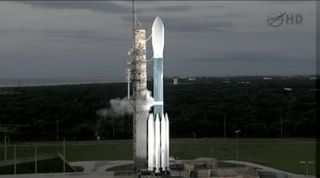High Winds Thwart NASA Launch of Twin Moon Gravity Probes

This story has been updated at 10:09 a.m. EDT.
Bad weather has forced NASA to delay today's launch of two new lunar probes that are designed to make detailed studies of the inside of the moon and its gravitational field. Windy conditions thwarted two available launch opportunities this morning (Sept. 8), so the agency will have to wait until tomorrow to try again.
NASA's twin Grail spacecraft were scheduled to blast off on an unmanned Delta 2 rocket at 8:37 a.m. EDT (1237 GMT) this morning from the Cape Canaveral Air Force Station in Florida, but upper level winds in the area caused the agency to stand down.
A second launch opportunity was available at 9:16 a.m. EDT (1316 GMT), but weather conditions did not improve, which forced NASA to hold off until tomorrow (Sept. 9). Current forecasts show a 40 percent chance that weather conditions will be acceptable for tomorrow's first launch opportunity at 8:33 a.m. EDT (1233 GMT), NASA officials told SPACE.com. [Photos of NASA's Grail Moon Gravity Mission]
A second launch opportunity is also available tomorrow at 9:12 a.m. EDT (1312 GMT), but forecasts indicate weather conditions are not expected to greatly improve until the weekend.
In addition to the threat of rain and thunderstorms, wind levels are monitored because they affect how rockets fly through Earth's upper atmosphere on their way into orbit. As a result, NASA sets limits on acceptable weather conditions to minimize any potential danger.
NASA has a 42-day window to launch the Grail spacecraft that extends through Oct. 19, agency officials have said.
Get the Space.com Newsletter
Breaking space news, the latest updates on rocket launches, skywatching events and more!
The $496 million Grail mission will study the lunar interior from crust to core, and will map the moon's gravitational field in unprecedented detail. The three-month expedition is expected to help scientists better understand the composition and evolutionary history of Earth's natural satellite. [Video: Grail's Mission to Map Moon Gravity]
Observations from the twin Grail probes are also expected to shed light on how other large, rocky bodies in the inner solar system formed.
You can follow SPACE.com staff writer Denise Chow on Twitter @denisechow. Follow SPACE.com for the latest in space science and exploration news on Twitter @Spacedotcom and on Facebook.
Join our Space Forums to keep talking space on the latest missions, night sky and more! And if you have a news tip, correction or comment, let us know at: community@space.com.

Denise Chow is a former Space.com staff writer who then worked as assistant managing editor at Live Science before moving to NBC News as a science reporter, where she focuses on general science and climate change. She spent two years with Space.com, writing about rocket launches and covering NASA's final three space shuttle missions, before joining the Live Science team in 2013. A Canadian transplant, Denise has a bachelor's degree from the University of Toronto, and a master's degree in journalism from New York University. At NBC News, Denise covers general science and climate change.
Most Popular

